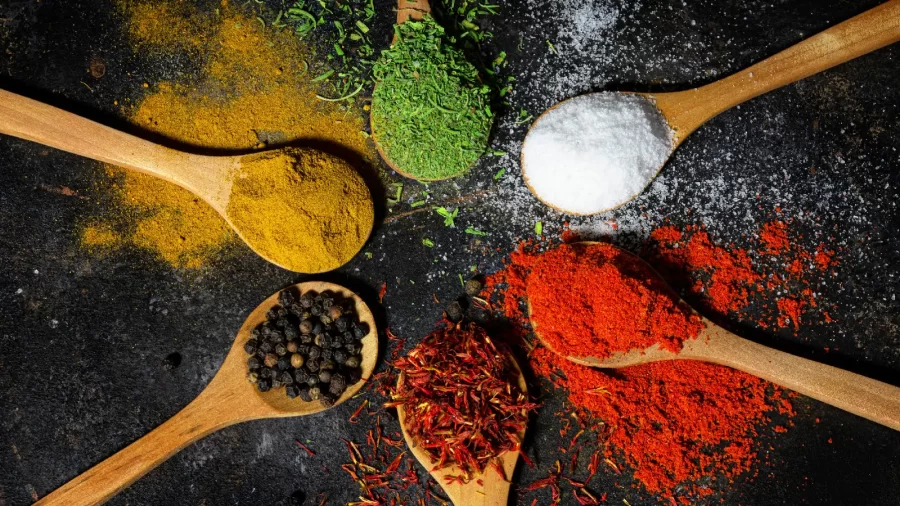What’s Up With Spice?
November 7, 2022
WAKE UP. SPICE ISN’T REAL. IT’S ALL IN YOUR HEAD.
Well, kinda.
Without going too much into biology and chemistry, spice is caused by a chemical called capsaicin. If you’ve ever heard the word “Scoville” on Hot Ones or in some crazy online pepper challenge, it’s simply a metric of the amount of capsaicin in a food. Higher scoville=more spice. When capsaicin hits your taste buds, it triggers the receptor that gauges the temperature of the food you are eating. Normally, this receptor is what allows you to distinguish between eating hot soup or cold ice cream. However, when capsaicin reacts with the receptor, it makes the receptor think that you are eating an extremely warm food, when in reality you are likely eating a room-temperature pepper. This receptor deception is why oftentimes you will begin to sweat after eating something really spicy: your body thinks that it’s overheating when in fact it isn’t.
Not all spice is created equal though. Have you ever noticed how some hot sauces only seem to burn your lips and tongue? Or that some peppers destroy not only your entire mouth but your throat as well? What about wasabi, which affects your nose instead of your mouth? Well, the chemical composition of each pepper can change the way that the capsaicin interacts with your taste buds. Additionally, some substances like wasabi don’t have any capsaicin, and instead, contain chemicals that are very closely related to capsaicin but behave slightly differently.
So, if spice’s effects are all mental and it isn’t harming you in any way physically, does that mean it’s okay to eat extremely spicy foods? For the most part, yes. Your body will stop itself before it consumes enough spice to kill itself. Does this mean that you should go around popping ghost peppers and Carolina reapers? Probably not. Your body’s method of stopping itself can be collapsing or going into shock, which are obviously not desirable outcomes. Hey, if you have an amazing spice tolerance, go for it, but if you think paprika and red pepper flakes are spicy, then maybe it isn’t the best idea to try the one-chip challenge.
Okay, but let’s say you did mess up and try the 7,000,000 Scoville scorpion death sauce or whatever. How do you cope with the pain? Well, if you’ve watched Hot Ones, you’ll know that everyone has their own kinds of elixirs and wive’s-tale remedies that they think will ease the burn. In reality, the cures are pretty simple- fat and sugar. Sugar will bind to your taste buds and prevent the capsaicin from attaching to the receptors. Fat is able to dissolve capsaicin because both molecules are extremely non-polar. For any chemistry-savvy folks out there, you’ll have already recognized that since fat is a good way of dealing with spice, water IS NOT. The polar water and nonpolar capsaicin repel each other, spreading the capsaicin around your mouth and making the pain worse. On the other hand, milk, a notorious spice counter, has understandably high levels of both sugar and fat. Olive oil and peanut butter are similarly renowned spice killers for their fat content.
For many people, it is difficult to understand why one would subject themselves to spicy foods. What’s the point of intentionally causing yourself pain? At a biological level, the pain of spice causes the body to release endorphins, pain-killing chemicals that make you feel better. Beyond that though, attitude towards spice can be determined at an individual and cultural level. Some people believe that spice enhances a meal and brings out flavors that would otherwise remain dormant. For others, the pain of spice distracts from the rest of the components of a dish. Culturally, America doesn’t focus too much on spice. Since fat and sugar are found in high quantities in American cuisine, spice doesn’t pair well with a lot of our iconic foods. Other countries, however, particularly in South America and Southeast Asia, place heavy emphasis on spice and incorporate it into many of their signature dishes.
If you’re like me and have a pitifully low spice tolerance, fear not—over time, your tolerance can slowly increase. The principle is the same as the way your body responds to any other stimuli: sensory adaptation. Your ears can tune out familiar background noise. Your eyes adjust to changes in lighting. Your skin gets used to hot temperatures in the summer and cold temperatures in winter. Likewise, your brain adapts to spicy food. If the brain is consistently receiving the same “spice signal” from your taste bud receptors, it will gradually respond less and less to the stimulus. So basically, if you want to get better at spice, you have to toughen up and gradually start eating more spicy foods so your brain learns to stop caring as much about them.
Hopefully, this has cleared up some of the common misconceptions about spice, and will inspire you to start experimenting with more spicy foods!


